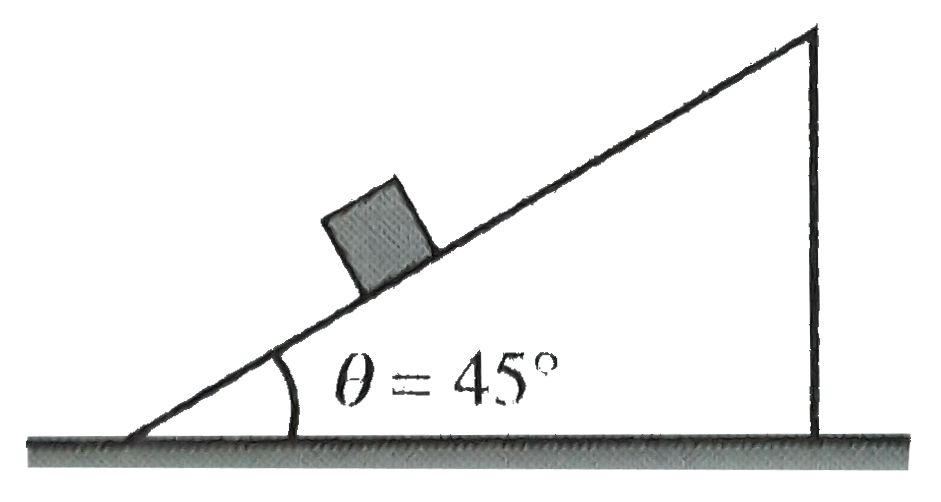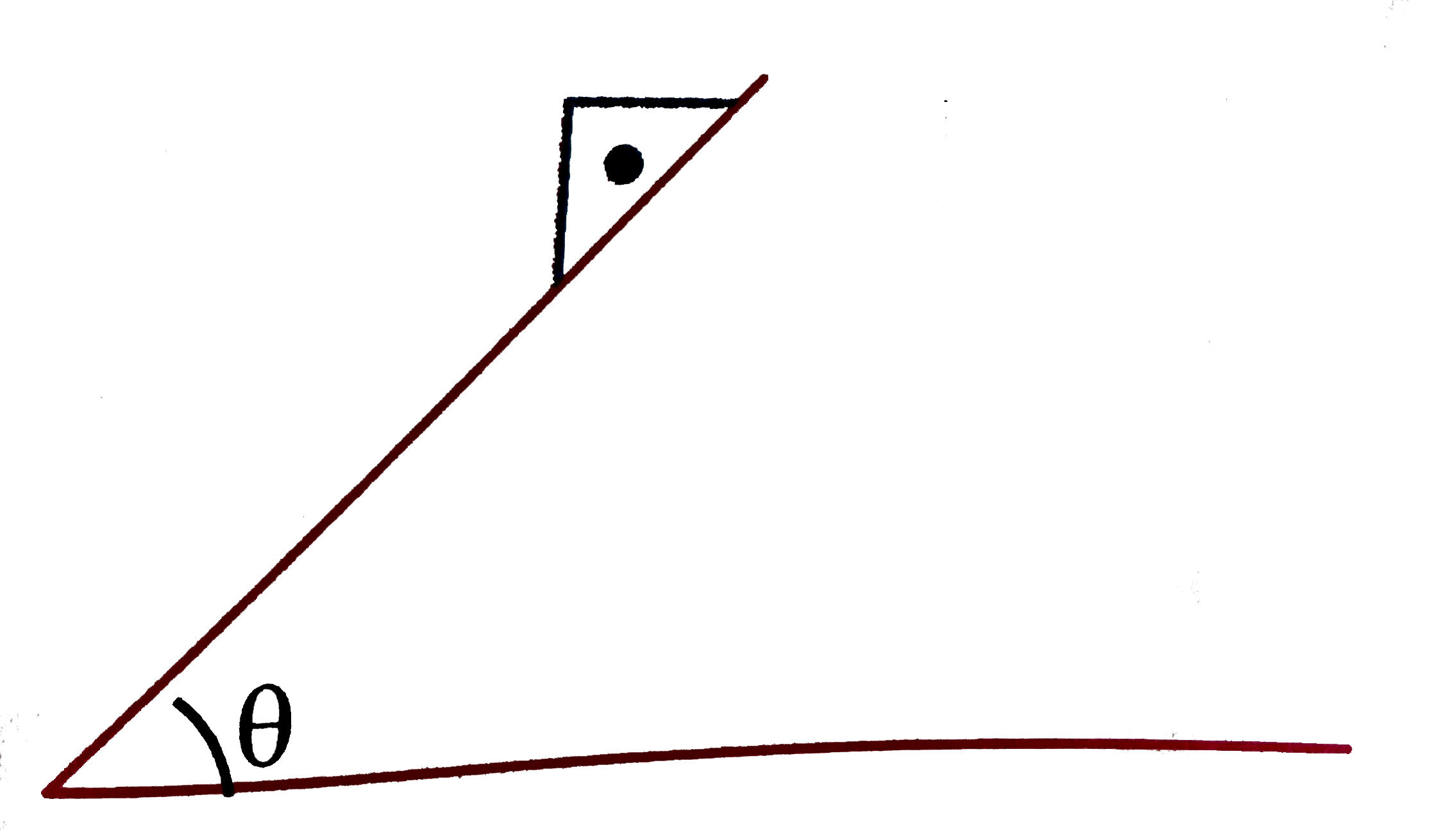A cubical block of mass M and edge a slides down a rougg inclined plane of inclination θ with a uniform velocity. The torque of the normal force on the block about its centre has magnitude.
zero
Mga
Mgasinθ
12Mgasinθ
The correct Answer is:D
To find the torque of the normal force on a cubical block of mass M and edge a sliding down a rough inclined plane with an inclination θ at uniform velocity, we can follow these steps:
Step 1: Identify the Forces Acting on the Block
The forces acting on the block are:
- The weight of the block, →W=M→g acting vertically downwards.
- The normal force →N acting perpendicular to the inclined surface.
- The frictional force →F acting parallel to the inclined surface, opposing the motion of the block.
Step 2: Resolve the Weight into Components
The weight can be resolved into two components:
- Perpendicular to the incline: W⊥=Mgcosθ
- Parallel to the incline: W∥=Mgsinθ
Step 3: Analyze Forces in the Direction Perpendicular to the Incline
Since the block is moving with uniform velocity down the incline, the net force in the direction perpendicular to the incline must be zero. Therefore, the normal force N must balance the perpendicular component of the weight:
N=Mgcosθ
Step 4: Analyze Forces in the Direction Parallel to the Incline
For the block to slide down with uniform velocity, the frictional force must balance the parallel component of the weight:
F=Mgsinθ
Step 5: Calculate the Torque Due to Normal Force
The torque τ due to the normal force about the center of the block is given by:
τN=N⋅d
where d is the perpendicular distance from the line of action of the normal force to the center of the block. Since the normal force acts at the edge of the block, the distance from the center to the edge is a2.
Thus, the torque due to the normal force is:
τN=N⋅a2=(Mgcosθ)⋅a2=Mgacosθ2
Step 6: Calculate the Torque Due to Friction
The torque due to the frictional force about the center of the block is:
τF=F⋅d
The distance d is also a2 since the friction acts at the bottom edge of the block. Therefore:
τF=(Mgsinθ)⋅a2=Mgasinθ2
Step 7: Equate the Torques
Since the block is not rotating, the net torque must be zero:
τN=τF
Thus:
Mgacosθ2=Mgasinθ2
Final Result
The torque of the normal force about the center of the block is:
Mgacosθ2
The forces acting on the block are:
- The weight of the block, →W=M→g acting vertically downwards.
- The normal force →N acting perpendicular to the inclined surface.
- The frictional force →F acting parallel to the inclined surface, opposing the motion of the block.
The weight can be resolved into two components:
- Perpendicular to the incline: W⊥=Mgcosθ
- Parallel to the incline: W∥=Mgsinθ
Since the block is moving with uniform velocity down the incline, the net force in the direction perpendicular to the incline must be zero. Therefore, the normal force N must balance the perpendicular component of the weight:
N=Mgcosθ
For the block to slide down with uniform velocity, the frictional force must balance the parallel component of the weight:
F=Mgsinθ
The torque τ due to the normal force about the center of the block is given by:
τN=N⋅d
where d is the perpendicular distance from the line of action of the normal force to the center of the block. Since the normal force acts at the edge of the block, the distance from the center to the edge is a2.
τN=N⋅a2=(Mgcosθ)⋅a2=Mgacosθ2
The torque due to the frictional force about the center of the block is:
τF=F⋅d
The distance d is also a2 since the friction acts at the bottom edge of the block. Therefore:
τF=(Mgsinθ)⋅a2=Mgasinθ2
Since the block is not rotating, the net torque must be zero:
τN=τF
Thus:
Mgacosθ2=Mgasinθ2
The torque of the normal force about the center of the block is:
Mgacosθ2
Topper's Solved these Questions
- ROTATIONAL MECHANICSBOOK - HC VERMACHAPTER - ROTATIONAL MECHANICSEXERCISE - Objective 2
15 Videos
- ROTATIONAL MECHANICSBOOK - HC VERMACHAPTER - ROTATIONAL MECHANICSEXERCISE - Exercises
86 Videos
- ROTATIONAL MECHANICSBOOK - HC VERMACHAPTER - ROTATIONAL MECHANICSEXERCISE - Short Answer
22 Videos
- REST AND MOTION : KINEMATICSBOOK - HC VERMACHAPTER - REST AND MOTION : KINEMATICSEXERCISE - Exercises
51 Videos
- SIMPLE HARMONIC MOTIONBOOK - HC VERMACHAPTER - SIMPLE HARMONIC MOTIONEXERCISE - Exercises
58 Videos
Similar Questions
A block of mass 250 g slides down an incline of inclination 370 with a uniform speed. Find the work done against the friction as the block slides through 1.0 m.
View SolutionA block of mass m=3kg slides on a rough inclined plane of cofficient of friction 0.2 Find the resultant force offered by the plane on the block

View Solution
Knowledge Check
A block of mas m begins to slide down on an inclined plane of inclination θ. The force of friction will be
AmgBmgcosθCmgsinθDmgtanθA block of mass m slides down a rough inclined plane of inclination θ with horizontal with zero initial velocity. The coefficient of friction between the block and the plane is μ with θ>tan−1(μ). Rate of work done by the force of friction at time t is
Aμmg2tsinθBmg2t(sinθ−μcosθ)Cμmg2tcosθ(sinθ−μcosθ)Dμmg2tcosθA block of mass m is placed on a smooth inclined plane of inclination θ with the horizontal. The force exerted by the plane on the block has a magnitude
AmgBmgcosθCmgcosθDmgtanθ
A block of mass m slides down a rough inclined plane of inclination θ with horizontal with zero initial velocity. The coefficient of friction between the block and the plane is μ with θ>tan−1(μ). Rate of work done by the force of friction at time t is
View SolutionA block of mass m slides down an inclined plane of inclination θ with uniform speed. The coefficient of friction between the block and the plane is μ. The contact force between the block and the plane is
View SolutionA block of mass m slides down an inclined plane of inclination θ with uniform speed The coefficient of friction between the block and the plane is μ. The contact force between the block and the plane is .
View SolutionA block can slide on a smooth inclined plane of inclination θ kept on the floor of a lift. When the lift is descending with a retardation a , the acceleration of the block relative to the incline is
View SolutionA block having equilateral triangular cross-section of side a and mass m is placed on a rough inclined surface, so that it remains in equilibrium as shown in figure. The torque of normal force acting on the block about its centre of mass is

View Solution
